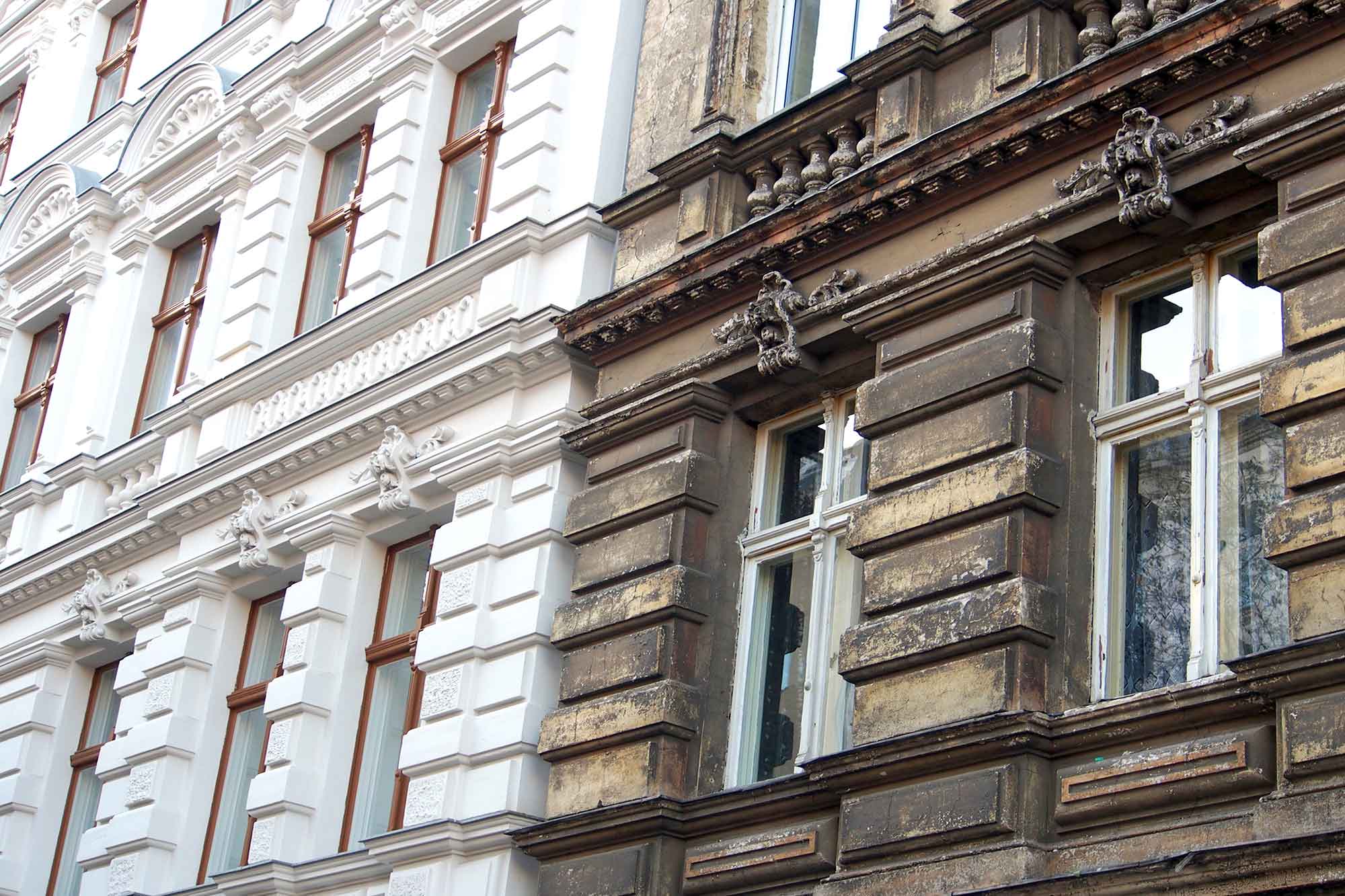Market & Figures / 13-04-2022

At the end of the day, the low rent they pay is well below the average of Pankow and Berlin. In return they predominantly reside in Wilhelmian style houses, have the Mauerpark park, 15 kindergartens and trendy bars right on their doorstep, and are only 15 minutes on the underground from Berlin Alexanderplatz. With the aim of preserving the “Bullerby” ambience, policymakers have invented social conservation areas intended to preserve the status quo 60 times in Berlin. They serve as a lever to prevent modernization programs, so that rents cannot be raised at all or only minimally. This is ensured by the rent index which exactly determines the net rent levels, excluding utilities, depending on the residential location, size and properties /age of the apartment that can be applied for rent hikes or new lets.
Social conservation areas prevent the free development of residential standards. Hence, the rent remains capped. This incidentally also applies to energy measures. Any measures that go beyond the minimum prescribed by federal law are not allowed. This means landlords cannot install the most energy efficient windows, but have to choose some that just about meet the minimum legal requirements. This also remains true for the facade; but only if more than 10% is damaged. An uninsulated but intact facade may not be renovated.
The social environment worth protection: High earners and professionals from Western countries
Every few years this carefully maintained status quo has to be reviewed, for “Falkplatz” this happened last in 2017. But, everything is delivered as ordered – this is ensured by the political ecosystem: Despite the prime residential location, excellent infrastructure and the fact that 82% of housing consisted of Wilhelmian style condominiums, the expertise still upheld the necessity to “protect” the American CFOs of start-ups, Latvian IT professionals or double-income civil servants – back then, incidentally, with an average rent of 6.50 euros per square meter, “far below the average rental price for the re-letting of premises of the last few years,” as the report stated.
And yet the monthly net income per household in this residential area averaged 2,500 euros in the survey period, while it was as low as 1,875 in Pankow and 1,775 euros in Berlin as a whole. At 1,800 euros at the time, the per capita income, too, was way above the comparable figure for Berlin, which amounted to only 1,418 euros. Only 8% of the residential population was considered at risk of poverty compared with 14% in the whole of Berlin. It is therefore no surprise that the housing cost burden – which represents the percentage of rental costs in the disposable income – amount to no more than 18%, while elsewhere in Pankow it was 27%. In view of the rising salaries, the rental cost burden had even dropped – though on average more living space was occupied.
The area around Falkplatz is only one example of many. By now social milieu protection covers almost the entire city center as well as large areas of the stereotypical Prenzlauer Berg. But in reality, a residential population transfer is being driven precisely by the fact that in this context no reasonable landlord would want to let residential living space to the agitated Berliners for the index-linked rents rigged by the Senate. Moreover, the situation is being aggravated by a blatant locked-in effect, since market rents are so much higher than the index-linked rents. In an “exemplary house” known to me in the area around Falkplatz – an older residential property built before 1918 comprising approximately 20 units – there are 1- and 4-person households, each in 75-m², 2-room flats, all with the same layout. The rents range from a phenomenal 3.50 euros to 13 euros, and an average of 6 euros, this is below the 6.50 euros for the entire residential area.
Under these circumstances relocation becomes entirely unattractive. For everybody has become accustomed to the artificially reduced rents and wants to sacrifice neither the living space nor the low tenancy ratio. This leads to an enormously undesirable effect at societal level. Four tenants share 75 square meters on their own and can also leave their flat vacant for months – this even though they have no steady income or depend on social transfers. On the other hand, they have weekend properties. Another Kiez resident is about to have a house built on the outskirts – and will keep her cheap 2-room rental flat in the city. Unthinkable in the rest of the world.

The essence of social conservation areas: preventing modernizations
Classification as a social conservation area “aims to protect the composition of the local population in a certain area by placing certain modifications under the reservation of an approval.” This prevents comprehensive modernizations that would raise the residential value – as such modernizations would require planning permission, which is often refused. Thus, any “changes and measures that affect rents and may result in a displacement of the residential population and therefore changes in the composition of the local population are to be restricted.” Permission for bathroom modernization, installation of a kitchen, attic conversions or the installation of elevators would result in “upward pressure for rents”, in other words: better living conditions – and, according to the advocates of this construct, would pose “a risk of displacement “.
The improvement measures having failed to materialize with the authorities’ blessings as a result are then categorized in a second step as “rent reducing” by the rent index. A central parameter here is the preferred “residential location”, of which there are only three levels in Berlin: “Falkplatz” belongs to the “medium” category, which leads to even further rent reductions. A trendy district in the neighborhood Prenzlauer Berg of the same category as Reinickendorf and Marzahn. Pure arbitrariness!
But how come the milieu protection is maintained? Well now, three decision criteria are assessed in a random matrix:
- Upward revaluation potential, “which may lead to rent increases following structural changes of the tenements”,
- Upward pressure on rents, i.e. “there is evidence that the scope for upward revaluation has already been or will be used in the near future” and the
- Risk of displacement – “if the residential population is generally susceptible to structural improvement processes and rent increases resulting therefrom”.
As rents are fairly cheap around Falkplatz square, there is a potential for upward revaluation. Strange world: Based on the foregoing a high real rent would be an argument for discontinuing milieu protection status. And many aspects are assessed according to this Kafkaesque method. The study states, for example, that it is a well-developed residential area in a preferred location with a thriving gastronomy typical of the local culture, which in turn indicates a particular attractiveness of the area. But this is bad, because of the “upward pressure” on rents. It is only with regard to the risk of the displacement of residents that the retainment of social conservation area status is dismissed in six of twelve points – as the adequate social situation cannot be denied.
In conclusion – the formal recommendation to retain the social conservation area requires some argumentative pirouettes: On the one hand the area is described as being attractive with regards to the buildings structure and gastronomy, which naturally attracts, but also retains people. At the same time, based on the arbitrary assessment matrix upward pressure on rents and upward revaluation potential are put forward – as if an improvement of living conditions were something evil.
Protecting residents against displacement works perfectly well for the German clientele of the Red-Green-Red city government – as the monthly rent is gratifyingly low. The global class of much sought-after professionals with an annual income of 100,000 euros will not be impressed by this. Of course, they too enjoy the rents that are ludicrously cheap by international comparison and so low that they might have mistaken to be quoted as the weekly not monthly rent. But if a head hunter from Stockholm, Dubai or Tel Aviv beckons, they are gone. Displaced not by pseudo-scientific characteristics such as “upward pressure on rents” and “upward revaluation potentials”, but by attractive tax regulations in the Emirates and smoothly functioning public authorities.

